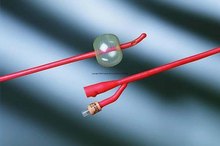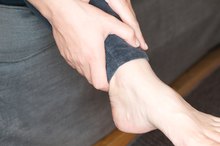How to Use Urinary Catheters With Diapers
Urinary catheters are often used in patients recovering from surgery or for those who can no longer control bladder function or have been diagnosed with a disease process that blocks the ureters or has damaged the urinary system. The catheter and diaper are also often needed in pediatric situations. A combination of a catheter and a brief, the more correct and dignity-saving term for adult diapers, is often seen in nursing homes or long term care facilities. Medical staff as well as home-based care givers can offer quality care for those using both catheter and brief by learning a few basic tips.
Inspect the catheter insertion site to make sure you don't see any signs of blood or infection. In men or women, the catheter is inserted into the urinary meatus 1. Once the catheter is in, a balloon is inflated to hold the catheter in place. You should be able to very gently tug on the catheter line to make sure it's in place and won't slip out.
Swimming With a Catheter
Learn More
Place the catheter line against one leg, making sure there's enough slack in the line to enable some movement. Velco straps are available from medical supply stores to help secure the catheter line against the thigh wherever it's most comfortable for the patient. For infants, toddlers and small children, ensure that the line offers enough room for movement without allowing so much that the toddler or child can play or pull out the catheter.
Prepare the diaper or brief, opening it up and laying it flat in preparation for use. Placement of the brief is the same for anyone, whether she's wearing a catheter or not.
How to Use a Fracture Bedpan
Learn More
Turn the patient so you can place the brief along her bottom, then pass the front end of the brief up in between her legs, making sure you don't crimp, bend or otherwise catch the catheter tube in the brief in the groin area. Attach the brief using the tabs provided for securing.
Attach the end of the catheter to a leg or drain bag. Catheters for infants may drain directly into the diaper, but others should be equipped with a bag to catch the urine. The catheter tubing should be long enough to allow placement of the bag around the lower part of the leg where it can be hidden in pants or under a lap blanket for dignity issues.
Attach the tubing to the lower calf with another Velcro strip to prevent either catheter tubing or urine bag from dragging on or touching the floor.
Related Articles
References
- National Institutes of Health: Urinary Catheters
- Håkansson MÅ. Reuse versus single-use catheters for intermittent catheterization: what is safe and preferred? Review of current status. Spinal Cord. 2014;52(7):511-6. doi:10.1038/sc.2014.79
- National Clinical Guideline Centre (UK), Royal College of Physicians (UK). Long term urinary catheters. In: Infection: prevention and control of healthcare-associated infections in primary and community care. London: National Clinical Guideline Centre, 2012.
- Willette PA, Coffield S. Current trends in the management of difficult urinary catheterizations. West J Emerg Med. 2012;13(6):472-8. doi:10.5811/westjem.2011.11.6810
- Cortese YJ, Wagner VE, Tierney M, Devine D, Fogarty A. Review of catheter-associated urinary tract infections and urinary tract models. J Healthc Eng. 2018;2018:2986742. doi:10.1155/2018/2986742
- Urinary catheter types and being part of the insertion team. Agency for Healthcare Research and Quality. Updated April 2017.
- Guide to implementing a program to reduce catheter-associated urinary tract infections in long-term care. Agency for Healthcare Research and Quality. Published March 2017.
- Urinary Catheters. Medline Plus. Updated January 6, 2020.
- Infection control: catheter-associated urinary tract infections. Summary of recommendations. Centers for Disease Control and Prevention. Updated November 5, 2015.
- Feneley RC, Hopley IB, Wells PN. Urinary catheters: history, current status, adverse events and research agenda [published correction appears in J Med Eng Technol. 2016;40(2):59]. J Med Eng Technol. 2015;39(8):459–470. doi:10.3109/03091902.2015.1085600
- Meddings J, Saint S, Fowler KE, et al. The Ann Arbor criteria for appropriate urinary catheter use in hospitalized medical patients: results obtained by using the RAND/UCLA appropriateness method. Ann Intern Med. 2015;162(9 Suppl):S1-34. doi:10.7326/M14-1304
Writer Bio
Denise Stern is an experienced freelance writer and editor. She has written professionally for more than seven years. Stern regularly provides content for health-related and elder-care websites and has an associate and specialized business degree in health information management and technology.









